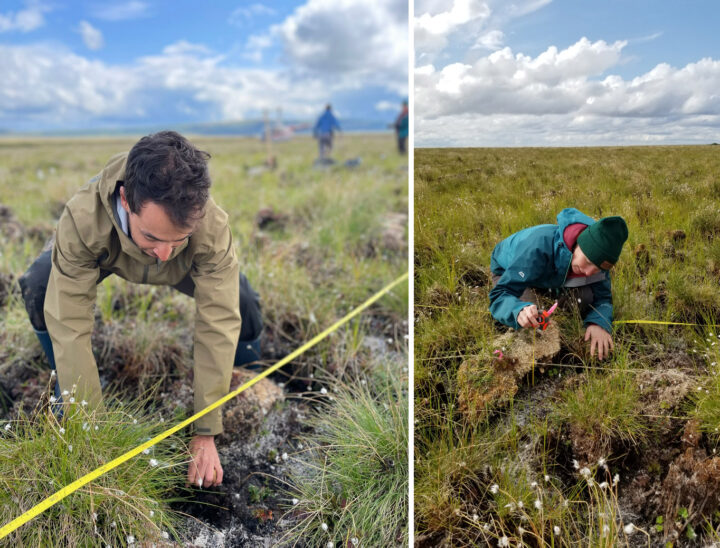I’m writing this post on our last day in St. Mary’s, Alaska. This tiny village of about 560 inhabitants had its surroundings ravaged by two large tundra fires in the summer of 2022. The East Fork fire was the second largest tundra fire in Alaska in over 40 years and the biggest in Southwest Alaska. These events were historic, and I could start this post by writing about the intense and productive three weeks of work we had here. However, this whole project started much earlier.
I started this Ph.D. with plans to do field work in Siberia. However, halfway through, due to the pandemic and geopolitical issues, I saw all those plans slip through my fingers. Despite being from a country with among the greatest biodiversity in the world (Brazil), the arctic-boreal environments have always fascinated me. So in the winter of last year, when I came across these fires while analyzing satellite images, I knew this was a unique opportunity to pack my bags and finally be in the tundra. I remember showing the first satellite images and data of these fires to my supervisor, Dr. Sander Veraverbeke, and he confirmed that these fires were indeed scientifically very interesting and logistically feasible for our expedition. From then on, a long process of preparation began.

As this field campaign is part of my Ph.D. project, I was responsible for planning both the scientific and logistical aspects. Now, reflecting after the final day of sampling, it is incredibly rewarding to see that the planning has paid off. We sampled 11 days by boat along the Andreafsky River sampling the East Fork fire and another five days by helicopter sampling the Apoon Pass fire. Our main goal was to estimate the carbon combustion from these fires, that is, the area-normalized emissions in grams of carbon per square meter. Field measurements are the prime way to accurately quantify carbon combustion. To do it, we collected soil samples and estimated the burn depth of the soil organic layer. It is crucial to advance the quantification of tundra fire carbon combustion and understanding its environmental drivers.

In addition to carbon emissions, another key point of our expedition is to understand the effects of fires on permafrost. Previous research has shown that fires in the boreal forest increase the thaw depth of the active layer above permafrost, which can lead to permafrost degradation. We are curious to investigate this mechanism in the tundra, even more so now that we have found ice-rich permafrost during our fieldwork.

But it was not just the work that was amazing during this campaign. The tundra landscape was always breathtaking. Both from above with the helicopter and along the river from the boat. We were presented with a stunning rainbow on our first day using the helicopter. Wildlife was always around: moose, bears, beavers, eagles, geese, and countless other bird species.


Lucas Ribeiro Diaz, Max van Gerrevink, Rebecca Scholten, Sonam Wangchuk, Thomas Janssen, Thomas Hessilt, and Sander Veraverbeke were part of this field expedition. Our team is part of the Climate & Ecosystems Change research group at the Vrije Universiteit Amsterdam. However, the success of this campaign would not have been possible without the help of our boat driver, David ‘Matty’ Beans, and our helicopter pilot, Savanna Paulsen. We are also grateful to the city of St. Mary’s and its people for warmly welcoming us during these weeks. Finally, Dr. Lisa Saperstein from the U.S. Fish and Wildlife Service in Alaska has provided tremendous help when we were organizing our campaign.

45 plots, 1,383 tussocks measured, 255 soil samples, 495 thaw depth measurements—numbers like these make us believe that we have just concluded a field campaign on some of the most densely sampled tundra fires in the history of science. Now, we have three more weeks of work ahead of us at the USGS soil laboratory in Anchorage. With lots of ideas in my head, I’m excited to see the new findings this valuable data can reveal!
I have just finished writing this post and I realize that perhaps it is too personal. But it could not be otherwise. Our science often blends in with who we are, our dreams and expectations. I leave St. Mary’s feeling fulfilled, I think I have always dreamed of being here. I leave the tundra sure that moments like this are the reason I decided to embark on this journey of doing research.
This tundra fires field expedition is part of FireIce (Fire in the land of ice: climatic drivers & feedbacks). FireIce is a Consolidator project funded by the European Research Council. FireIce is affiliated with NASA ABoVE. This blog post was written by Lucas Ribeiro Diaz, a Ph.D. student at Vrije Universiteit Amsterdam, studying arctic-boreal fires by combining field and remote sensing approaches.
Tags: Alaska, Carbon cycle, fire, FireIce, tundra



